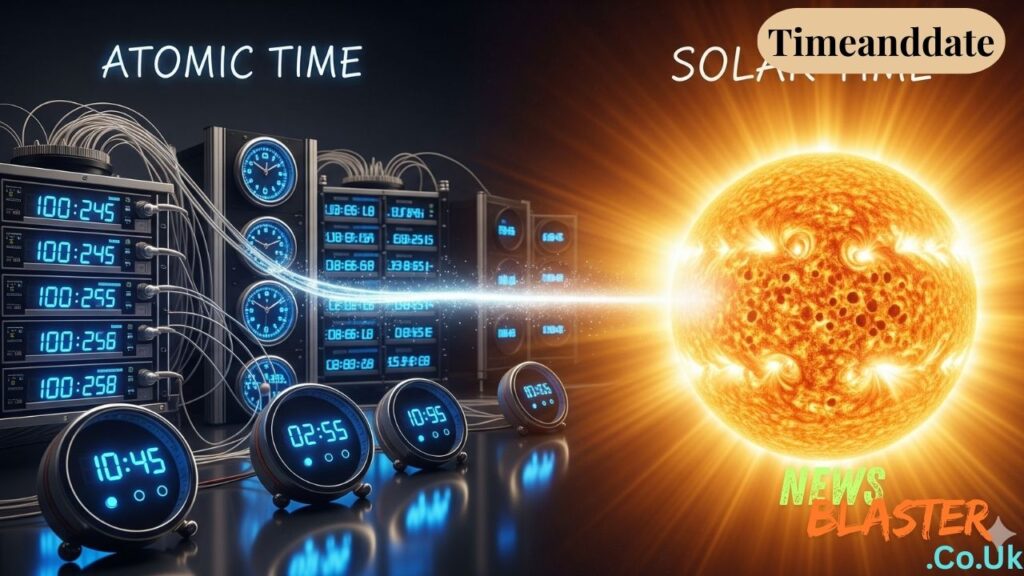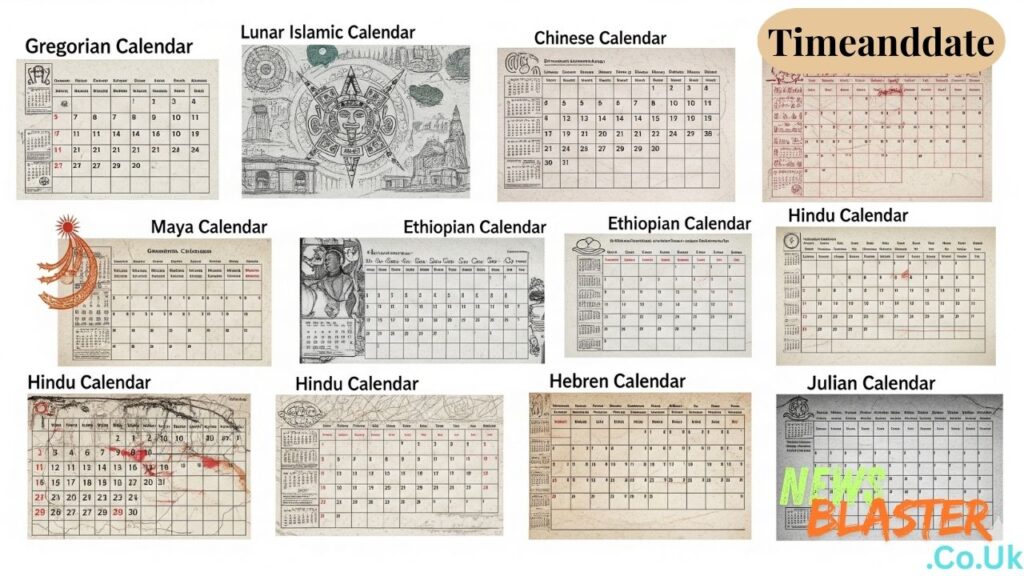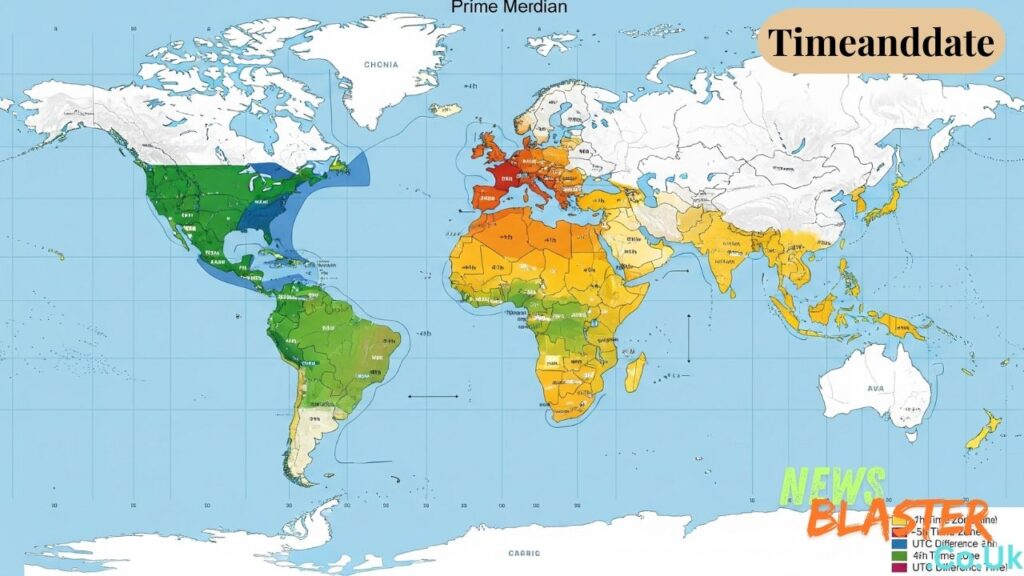Time governs every aspect of human life, from scheduling meetings to planning vacations. Understanding how time and date systems work has become increasingly important in our interconnected world. This comprehensive guide explores everything from basic timekeeping concepts to advanced calendar systems and practical applications.
Understanding the Fundamentals of Time
What is Time?
Time represents a continuous sequence of existence and events that occur in apparently irreversible succession from the past, through the present, and into the future. Modern civilization relies on precise time measurement for countless daily activities, from catching trains to coordinating global communications.
The concept of measuring time has evolved dramatically throughout history. Early civilizations used natural phenomena like the sun’s position and moon phases to track time. Today’s atomic clocks provide accuracy to within nanoseconds, enabling GPS navigation and high-speed financial transactions.
Scientists distinguish between two primary time standards: atomic time, which uses the vibrations of atoms for precise measurement, and solar time, which follows the Earth’s rotation relative to the sun. Most modern systems blend both approaches to maintain accuracy while staying synchronized with natural day-night cycles.
Calendar Systems Around the World
The Gregorian calendar serves as the international standard for civil purposes worldwide. Pope Gregory XIII introduced this system in 1582 to correct inaccuracies in the earlier Julian calendar. The Gregorian calendar’s 365.2425-day average year closely matches Earth’s orbital period around the sun.

Historical calendars reveal fascinating insights into different cultures’ approaches to timekeeping. The Julian calendar, used by ancient Rome, accumulated errors over centuries because its 365.25-day year slightly exceeded Earth’s actual orbital period. Ancient lunar calendars followed moon phases but required complex adjustments to stay aligned with seasons.
Many cultures maintain traditional calendar systems alongside the Gregorian calendar. The Islamic calendar follows pure lunar cycles, while the Chinese calendar combines lunar months with solar year adjustments. Jewish, Hindu, and Buddhist calendars each reflect unique cultural and religious traditions that continue influencing millions of people today.
Time Zones and Global Coordination
Understanding Time Zone Systems
Coordinated Universal Time (UTC) serves as the foundation for global timekeeping. This standard emerged from the need to coordinate activities across different regions without confusion. UTC maintains consistency through atomic clock networks and provides the reference point for all other time zones worldwide.
Many people confuse Greenwich Mean Time (GMT) with UTC, but important distinctions exist. GMT originally referred to mean solar time at Greenwich, England, while UTC represents an atomic time standard. Modern systems use UTC as the primary reference, though GMT remains common in casual usage.
Time zone boundaries don’t always follow logical geographical lines. Political considerations, economic relationships, and historical factors influence these decisions. Some countries span multiple time zones, while others maintain uniform time across vast territories that would naturally fall into different zones.
Daylight Saving Time Complexities
Daylight Saving Time (DST) represents one of the most debated aspects of modern timekeeping. Originally proposed during World War I to conserve energy, DST now affects billions of people annually. The practice involves moving clocks forward one hour during warmer months to extend evening daylight.
Global DST implementation varies significantly. Some countries observe DST nationwide, others apply it regionally, and many have abandoned the practice entirely. These variations create challenges for international business, travel planning, and digital systems that must accommodate changing time differences throughout the year.
Research suggests DST’s original energy-saving benefits have diminished in modern society. Air conditioning usage during extended evening daylight may offset lighting savings. Health studies indicate DST transitions can disrupt sleep patterns and increase accident rates, leading some regions to reconsider their policies.
World Clock Features and Applications
Modern world clock systems provide essential tools for global communication and business. These platforms display multiple time zones simultaneously, helping users coordinate across different regions. Features typically include major city times, customizable location lists, and visual indicators for business hours.
Professional applications require sophisticated scheduling tools that account for time zone differences and DST changes. Meeting schedulers can identify optimal times when participants across multiple zones are available. Some systems even factor in cultural preferences, avoiding scheduling during religious observances or national holidays.
Advanced world clock features include sunrise and sunset times, which vary by location and season. These astronomical calculations help travelers adjust to new time zones and assist photographers planning outdoor shoots. Integration with calendar applications enables automatic time zone conversion for scheduled events.
Date and Time Calculations
Date Arithmetic Fundamentals
Date arithmetic involves adding or subtracting time periods to determine past or future dates. This seemingly simple process becomes complex when accounting for varying month lengths, leap years, and calendar system differences. Accurate calculations require understanding these underlying complexities.

Leap year calculations follow specific rules within the Gregorian calendar system. Years divisible by four are typically leap years, except for years divisible by 100. However, years divisible by 400 are leap years despite being divisible by 100. These rules maintain calendar accuracy over centuries.
Business day calculations exclude weekends and holidays, varying by country and organization. International businesses must consider different holiday calendars when calculating delivery dates, project timelines, and payment schedules. Some systems allow custom business day definitions for specific industries or regions.
Time Duration Calculations
Calculating time differences between dates requires careful handling of various units and time zones. Simple subtraction works for dates within the same time zone, but international calculations must account for time zone differences and potential DST changes during the period.
Age calculators represent common applications of time duration calculations. These tools determine precise ages in years, months, and days, accounting for leap years and varying month lengths. Legal and medical applications often require exact age calculations for eligibility determinations.
Event countdown timers provide practical applications for time duration calculations. These tools display remaining time until future events, automatically updating to reflect the decreasing interval. Wedding planners, project managers, and event organizers rely on these calculations for coordination and planning.
Calendar Utilities and Tools
Day-of-week calculators determine which day any historical or future date falls on. These tools use mathematical algorithms that account for leap years and calendar system changes. Historical researchers, genealogists, and curious individuals frequently use these calculations.
Week numbering systems vary internationally, creating potential confusion in business contexts. ISO 8601 defines a standard week numbering system, but some countries follow different conventions. Understanding these differences helps prevent scheduling conflicts and miscommunications.
Holiday date calculations accommodate both fixed dates like Christmas and variable dates like Easter. Easter’s calculation involves complex lunar calculations that can result in dates ranging from late March to late April. Business systems must account for these variations when scheduling operations and deliveries.
Practical Applications and Tools
Event Planning Solutions
Event planning across multiple time zones requires sophisticated coordination tools. Modern platforms help organizers schedule events at times convenient for global participants. These systems consider not only time differences but also cultural preferences and typical business hours.
Countdown timers create excitement and urgency for upcoming events. Marketing campaigns frequently use these tools to build anticipation for product launches, sales events, or special occasions. The psychological impact of visible countdowns can significantly influence consumer behavior and engagement.
Event time converters help participants understand local times for global events. These tools automatically convert announced times into users’ local time zones, reducing confusion and missed appointments. Integration with calendar applications enables automatic reminders adjusted for local time.
Travel and Business Applications
International travel involves constant time zone calculations. Flight arrival and departure times, hotel check-in schedules, and meeting appointments all require conversion between different time zones. Modern travel apps automate these calculations, reducing traveler stress and preventing missed connections.
Jet lag results from disrupting the body’s internal clock when crossing time zones rapidly. Understanding time differences helps travelers prepare for jet lag effects and plan recovery strategies. Some applications provide personalized advice for minimizing jet lag based on flight details and individual sleep patterns.
International calling requires awareness of time differences to avoid disturbing contacts during inappropriate hours. Smart dialing applications display local times for contacts and suggest optimal calling windows. Business communication platforms often integrate these features to facilitate global collaboration.
Historical Research Applications
Historical date research helps genealogists, historians, and curious individuals understand past events’ timing. Determining what day of the week historical events occurred provides context and helps verify historical accounts. These calculations require understanding calendar system changes throughout history.
Historical event timelines benefit from accurate date calculations that account for different calendar systems used throughout history. Converting between Julian and Gregorian calendars helps researchers understand timing relationships between events in different regions or time periods.
Date format conversions accommodate different regional preferences and historical conventions. American, European, and international formats can create confusion when interpreting historical documents. Understanding these conventions helps researchers accurately interpret dates in various sources.
Technical Implementation Considerations

Programming with Dates and Times
Software developers face numerous challenges when working with dates and times. Popular programming languages provide libraries for handling these complexities, but developers must understand underlying concepts to avoid common pitfalls. Time zone handling, leap year calculations, and DST transitions require careful consideration.
Time zone handling in code requires robust databases that track historical changes and future planned modifications. The IANA Time Zone Database provides authoritative information for software systems worldwide. Regular updates ensure applications handle time zone changes correctly.
Database storage considerations become crucial for applications serving global users. Storing times in UTC and converting to local time zones for display prevents many common errors. However, some applications require storing local times to preserve user intent, particularly for future events that might be affected by time zone rule changes.
API and Data Sources
Time zone databases require regular maintenance to reflect government policy changes. The Internet Assigned Numbers Authority (IANA) maintains the authoritative time zone database used by most software systems. Updates address new time zone creations, boundary changes, and DST rule modifications.
Holiday APIs provide structured access to holiday information across different countries and cultures. These services help applications avoid scheduling conflicts and respect cultural observances. Commercial and open-source options exist with varying levels of detail and accuracy.
Astronomical calculations enable applications to determine sunrise, sunset, moon phases, and eclipse dates. These calculations require complex mathematical algorithms that account for Earth’s orbital variations and geographical differences. Specialized libraries simplify integration of these features into applications.
Special Features and Advanced Tools
Astronomical Information Integration
Sunrise and sunset times vary by location and season, following predictable astronomical patterns. These calculations help photographers plan shoots, gardeners optimize planting schedules, and travelers understand local daylight patterns. Integration with weather services provides comprehensive environmental planning tools.
Moon phase information appeals to various user groups, from astronomy enthusiasts to farmers following lunar planting calendars. Accurate phase calculations require complex mathematical models that account for the moon’s elliptical orbit and varying distance from Earth.
Solar and lunar eclipse predictions generate significant public interest during eclipse events. These calculations require precise astronomical models and geographical considerations to determine visibility zones. Educational applications often integrate eclipse information to promote scientific interest and awareness.
Calendar Conversion Systems
Converting between different calendar systems requires understanding each system’s unique rules and historical context. Religious calendars often follow lunar cycles with various adjustment mechanisms. Academic and historical research frequently requires these conversion capabilities.
Religious calendar conversions serve communities maintaining traditional observances alongside modern civil calendars. Islamic, Jewish, Hindu, and other religious calendars each follow distinct calculation methods. Accurate conversion tools help communities plan religious events and observances.
Historical date conversions account for calendar system changes that occurred at different times in different regions. The Gregorian calendar adoption varied by country, with some regions maintaining Julian dates centuries after Gregorian introduction. Historical research requires understanding these transition periods.
Scheduling Assistant Features
Optimal meeting time calculations consider multiple participants across different time zones, identifying windows when all attendees are available during reasonable hours. These tools factor in cultural preferences, avoiding scheduling during traditional lunch hours or religious observances.
Recurring event calculations handle complex patterns like “the second Tuesday of each month” or “every weekday except holidays.” These calculations must account for varying month lengths, leap years, and changing holiday dates. Business applications rely on these features for payroll, billing, and operational scheduling.
Availability overlay features help users visualize schedule conflicts across multiple calendar systems. Integration with popular calendar platforms enables comprehensive scheduling without requiring participants to share detailed calendar information. Privacy controls ensure appropriate information sharing levels.
Mobile and Accessibility Features
Mobile Application Capabilities
Offline functionality ensures time and date information remains accessible without internet connectivity. Mobile applications cache essential data like time zone rules and holiday information. This capability proves crucial for travelers in areas with limited connectivity.
Widget displays provide quick access to time and date information directly from device home screens. Users can customize these widgets to show multiple time zones, countdown timers, or calendar information. Integration with device notification systems enables time-based alerts and reminders.
Notification systems help users stay aware of time-sensitive information like meeting reminders, time zone changes during travel, or countdown completion. Smart notification timing considers user sleep schedules and timezone changes to optimize alert delivery.
Accessibility Design Principles
Screen reader compatibility ensures visually impaired users can access time and date information effectively. Proper semantic markup and descriptive text enable assistive technologies to convey information clearly. Audio formats can supplement visual displays for enhanced accessibility.
Voice input and output capabilities accommodate users with mobility limitations or situations where hands-free operation is preferred. Natural language processing enables commands like “set a timer for 15 minutes” or “what time is it in Tokyo?” Voice responses provide information without requiring visual attention.
Visual impairment accommodations include high contrast displays, large font options, and tactile feedback systems. These features help users with varying degrees of visual capability access time and date information effectively. Color-blind friendly designs ensure information remains accessible regardless of color perception abilities.
Maintaining Accuracy and Reliability
Time Zone Database Updates
Government changes to DST rules require prompt updates to time zone databases. Political decisions can affect millions of users instantly, making rapid distribution of updates crucial. Automated update systems help ensure applications reflect current rules without manual intervention.
Political boundary modifications occasionally result in time zone changes as regions align with different administrative centers. These changes require comprehensive updates to mapping databases and user interface displays. Historical data preservation ensures past calculations remain accurate.
Database synchronization across multiple systems prevents inconsistencies that could cause scheduling conflicts or missed appointments. Distributed systems require coordination mechanisms to ensure all components reflect identical time zone information. Version control helps track changes and resolve discrepancies.
Leap Second Management
Leap seconds represent rare but significant events in precise timekeeping. These adjustments maintain synchronization between atomic time and Earth’s rotation, which varies slightly due to geological and atmospheric factors. Technical systems must handle these adjustments without disrupting operations.
System update procedures for leap second implementation require careful coordination across interconnected systems. Financial markets, telecommunications networks, and scientific instruments must implement changes simultaneously to prevent timing discrepancies.
Historical leap second records help validate timing calculations for past events and enable accurate predictions for future adjustments. The irregular nature of leap second additions makes prediction difficult, requiring ongoing monitoring of Earth’s rotation rate.
User Experience and Interface Design
Intuitive Design Principles
Clear time zone indicators prevent confusion when displaying times from multiple regions. Visual cues like color coding, flags, or city names help users quickly identify which time zone each display represents. Consistent formatting across all displays reduces cognitive load and prevents misinterpretation.
Date format consistency accommodates user preferences while maintaining clarity. International users expect different date formats, from MM/DD/YYYY in the United States to DD/MM/YYYY in Europe to YYYY-MM-DD in ISO format. Flexible systems allow user customization while clearly indicating the chosen format.
Error prevention mechanisms help users avoid common mistakes like scheduling meetings at inappropriate times or misinterpreting date formats. Smart defaults, validation checks, and confirmation dialogs reduce the likelihood of costly errors in time-sensitive applications.
Customization and Personalization
Personal time zone preferences enable users to prioritize locations relevant to their needs. Business travelers might track multiple cities, while remote workers focus on team member locations. Customizable displays accommodate these varying requirements.
Date format selections respect cultural preferences and professional requirements. Legal documents, scientific papers, and business communications may require specific formats. User control over these preferences improves satisfaction and prevents formatting conflicts.
Favorite location management helps users quickly access frequently needed time zone information. Smart systems might suggest locations based on usage patterns, recent travel, or calendar appointments. Integration with contact management systems can automatically display time zones for scheduled meeting participants.
Future Trends and Innovations
Emerging Technology Integration
Internet of Things (IoT) device synchronization requires precise time coordination across numerous connected devices. Smart homes, industrial sensors, and wearable devices all depend on accurate timing for proper operation. Edge computing introduces additional challenges for maintaining time synchronization in distributed systems.
Blockchain applications rely on accurate timestamps for transaction validation and chronological ordering. Distributed ledger systems require consensus mechanisms that account for network delays and varying local times. Time-based smart contracts depend on reliable external time sources for execution triggers.
Artificial intelligence-powered scheduling systems can learn user preferences and optimize meeting times automatically. These systems might consider factors like productivity patterns, travel schedules, and team dynamics to suggest optimal scheduling options. Machine learning enables continuous improvement in scheduling recommendations.
Global Standardization Evolution
Time zone reform discussions periodically emerge as regions reconsider DST policies and time zone alignments. Some proposals suggest eliminating DST entirely, while others propose permanent DST adoption. These changes would affect millions of people and require extensive coordination across interconnected systems.
Digital calendar evolution continues as new technologies enable enhanced functionality. Integration with augmented reality systems might overlay scheduling information onto real-world environments. Virtual and mixed reality applications require precise timing coordination for shared experiences.
International cooperation initiatives work toward improved global time standards and coordination mechanisms. Scientific organizations collaborate on leap second policies, while technology companies coordinate to ensure smooth transitions during time-related changes. These efforts help maintain the reliable timekeeping infrastructure modern society depends upon. Leading timeanddate com platforms participate actively in these standardization efforts, ensuring their services remain compatible with evolving global standards.
Also Read: Trucofax Your Ultimate Guide to Smart, Actionable Knowledge

